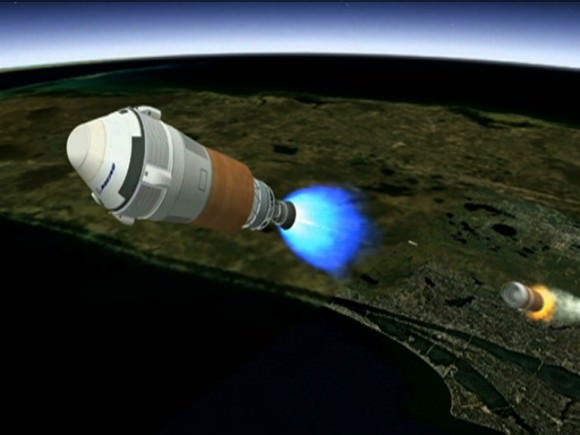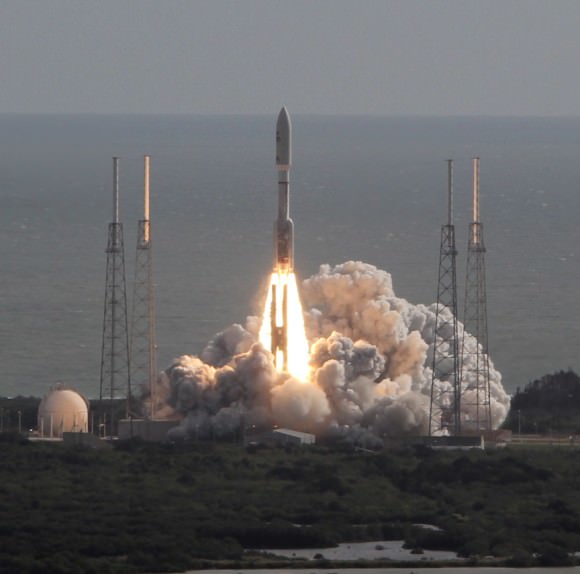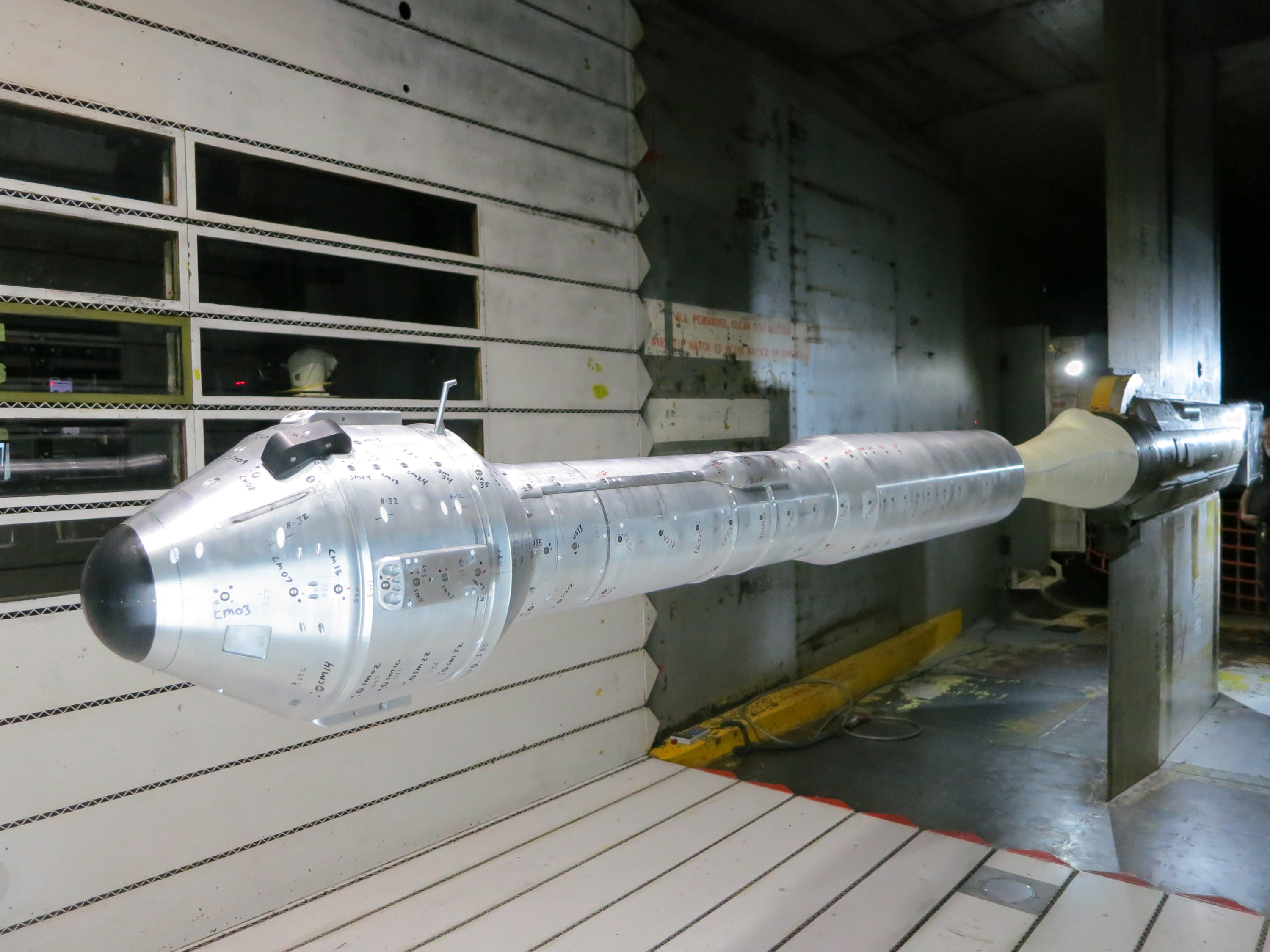The next time that American astronauts launch to space from American soil it will surely be aboard one of the new commercially built “space taxis” currently under development by a trio of American aerospace firms – Boeing, SpaceX and Sierra Nevada Corp – enabled by seed money from NASA’s Commercial Crew Program (CCP).
Boeing has moved considerably closer towards regaining America’s lost capability to launch humans to space when the firm’s privately built CST-100 crew capsule achieved two key new milestones on the path to blastoff from Florida’s Space Coast.
The CST-100 capsule is designed to carry a crew of up to 7 astronauts on missions to low-Earth orbit (LEO) and the International Space Station (ISS) around the middle of this decade.

Boeing’s crew transporter will fly to space atop the venerable Atlas V rocket built by United Launch Alliance (ULA) from Launch Complex 41 on Cape Canaveral Air Force Station in Florida.
The Boeing and ULA teams recently completed the first wind tunnel tests of a 7 percent scale model of the integrated capsule and Atlas V rocket (photo above) as well as thrust tests of the modified Centaur upper stage.
The work is being done under the auspices of NASA’s Commercial Crew Integrated Capability (CCiCap) initiative, intended to make commercial human spaceflight services available for both US government and commercial customers, such as the proposed Bigelow Aerospace mini space station.

Since its maiden liftoff in 2002, the ULA Atlas V rocket has flawlessly launched numerous multi-billion dollar NASA planetary science missions like the Curiosity Mars rover, Juno Jupiter orbiter and New Horizons mission to Pluto as well as a plethora of top secret Air Force spy satellites.
But the two stage Atlas V has never before been used to launch humans to space – therefore necessitating rigorous testing and upgrades to qualify the entire vehicle and both stages to meet stringent human rating requirements.
“The Centaur has a long and storied past of launching the agency’s most successful spacecraft to other worlds,” said Ed Mango, NASA’s CCP manager at the agency’s Kennedy Space Center in Florida. “Because it has never been used for human spaceflight before, these tests are critical to ensuring a smooth and safe performance for the crew members who will be riding atop the human-rated Atlas V.”
The combined scale model CST-100 capsule and complete Atlas V rocket were evaluated for two months of testing this spring inside an 11- foot diameter transonic wind tunnel at NASA’s Ames Research Center in Moffett Field, Calif.
“The CST-100 and Atlas V, connected with the launch vehicle adaptor, performed exactly as expected and confirmed our expectations of how they will perform together in flight,” said John Mulholland, Boeing vice president and program manager for Commercial Programs.
Testing of the Centaur stage centered on characterizing the flow of liquid oxygen from the oxygen tank through the liquid oxygen-feed duct line into the pair of RL-10 engines where the propellant is mixed with liquid hydrogen and burned to create thrust to propel the CST-100 into orbit.
Boeing is aiming for an initial three day manned orbital test flight of the CST-100 during 2016, says Mulholland.

But that date is dependent on funding from NASA and could easily be delayed by the ongoing sequester which has slashed NASA’s and all Federal budgets.
Chris Ferguson, the commander of the final shuttle flight (STS-135) by Atlantis, is leading Boeing’s flight test effort.
Boeing has leased one of NASA’s Orbiter Processing Facility hangers (OPF-3) at the Kennedy Space Center (KSC) for the manufacturing and assembly of its CST-100 spacecraft.
Mulholland told me previously that Boeing will ‘cut metal’ soon. “Our first piece of flight design hardware will be delivered to KSC and OPF-3 around mid 2013.”
NASA’s CCP program is fostering the development of the CST-100 as well as the SpaceX Dragon and Sierra Nevada Dream Chaser to replace the crew capability of NASA’s space shuttle orbiters.
The Atlas V will also serve as the launcher for the Sierra Nevada Dream Chaser space taxi.
Since the forced retirement of NASA’s shuttle fleet in 2011, US and partner astronauts have been 100% reliant on the Russians to hitch a ride to the ISS aboard the Soyuz capsules – at a price tag exceeding $60 Million per seat.
Simultaneously on a parallel track NASA is developing the Orion crew capsule and SLS heavy lift booster to send humans to the Moon and deep space destinations including Asteroids and Mars.
And don’t forget to “Send Your Name to Mars” aboard NASA’s MAVEN orbiter- details here. Deadline: July 1, 2013
…………….
Learn more about Conjunctions, Mars, Curiosity, Opportunity, MAVEN, LADEE and NASA missions at Ken’s upcoming lecture presentations:
June 4: “Send your Name to Mars” and “CIBER Astro Sat, LADEE Lunar & Antares ISS Rocket Launches from Virginia”; Rodeway Inn, Chincoteague, VA, 8:30 PM
June 11: “Send your Name to Mars” and “LADEE Lunar & Antares ISS Rocket Launches from Virginia”; NJ State Museum Planetarium and Amateur Astronomers Association of Princeton (AAAP), Trenton, NJ, 730 PM.
June 12: “Send your Name to Mars” and “LADEE Lunar & Antares ISS Rocket Launches from Virginia”; Franklin Institute and Rittenhouse Astronomical Society, Philadelphia, PA, 8 PM.




Maybe they should hire a artist to make this rocket more sexy. e.g. someone that designed Ferrari’s.
When you have a rocket that can accelerate you from 0..100 km/h in 0.1 seconds you expect some flashy colours and a cool streamlined design to impress chicks.
Yeah, but flashy cars are useless for carrying groceries from the supermarket or supplies from the hardware store.
well said!
And there’s nowhere to put the kids either.
The Atlas V is a super sexy rocket. I been up close with her many times
It’s unfortunate the (incredibly expensive, unsafe, and incapable of going higher than low earth orbit) space shuttle wasn’t retired much sooner, or we’d have these improved launch vehicles.
In the artist’s image above there is no indication of how the crew will get into and out of the capsule. What method will be used? A removable gantry? If so, when will that infrastructure be built? Are there any artist renderings available you might show us?
On the pad, from a gantry, via hatches in the side, as has always been the case, even with the Shuttle…?
http://www.americaspace.org/wp-content/uploads/2012/05/dc_crew2-500×309.jpg
http://images.spaceref.com/news/2010/ooDeltaIV.jpg
For station docking, the connection will be at the top for SCT-100, just like Apollo:
http://www.satnews.com/images_upload/893778359/Boeing_CST-100.jpg
And Dream Chaser will dock ‘backwards’ into a station docking port:
http://www.sen.com/uploads/articles/detail/6fef1cf9d51846ee8426c0c866c14382.jpg
….Seriously, there’s no mystery here,
Just curious… I haven’t seen the intended manned launch gantry. I can imagine it will look like the gantry above, mounted horizontal on a rail car and erected at the pad. That gantry will probably have an elevator and a retractable access platform?
Yes. Precisely as has been the case for all other manned orbital vehicles I’m aware of. Just guessing now, but I’d think they’d also have the Apollo/Shuttle like quick getaway wire slide to a nearby bunker or armored personnel carrier, for a dangerous situation where there’s no time to descend on the elevator.
And unlike the Shuttle (but as the Russians had to do once, when a Soyuz launcher caught fire on the pad), it’s also possible for CST-100 and Dream Chaser vehicles to do an abort away from the launcher, right off the pad, when that’s clearly preferable to an emergency egress…
You nailed it.
The space shuttle and the ISS have done more harm to space travel and technological progress than all those neo-Luddites in the congress and all the budget cuts.
Let’s hope the ISS gets deorbited soon before more money gets wasted in space taxi services to this piece of space junk in low earth orbit that has produced absolutely nothing in its entire history.
Now that it’s just the Soyouz going back and forth it’s not so bad. We’re getting good data on human biology in weightlessness, and the engineers have been poring over breakdowns and issues to develop better systems.
So I see where you are coming from, but I don’t think it’s space junk. The Space Shuttle was a ridiculous boondoggle, but I’m cool with the ISS.
NASA daring to go where we have gone before…
Can we say, “…pork barrel jobs program…”
50 years and still no SSTO vehicles. That’s a crime.
While SSTO’s have been studied in the past, the problem is that the usable payload of an SSTO would be tiny given current rocket technology.
It will be interesting to see how far Reaction Engines Ltd gets with Skylon.
Gotta love those disintegrating totem poles™!
It’s unfortunate that Congress annually allocated only about half of the $850 USD requested, or we’d be closer to this capability, anyway.
NASA’s new policy to sign up private contractors is a game changer and will change space travel.. Musk and Space X is a starter..
$2 billion a year whether is flies or not (gotta keep the same 20,000 scientist and engineers employed that we’ve kept employed since Skylab).
That. Is. A. Shame.
There’is real truth in what you have explained. Also, the whole political system is shameful. We should have a ‘national vote’ on all huge monetary, personal, and moral laws. The few who are in power like the court systems, congress, or state legislators should ‘not’ have the only votes. We are all in this together. We should ‘all vote’ together for any huge monetary, personal and moral issues.
The shuttle was indeed a boondoggle… The original design was for a much more robust launcher and orbiter. That design used a winged rocket and jet powered mother ship first stage which would fly back to the Cape after launch. That vehicle was similar to today’s White Knight of Scaled Composites fame. The Nixon administration was instrumental in redirecting intended funding. Two words – Viet Nam. They cut the program wherever they could. The worst cut was made was in quality… duh… Instead of using HIGHLY reliable equipment = $$$ they opted to use triple redundancy with lesser quality and cost units wherever they could. This made for a much heavier shuttle… Which co-incidentally worked out well for some because it meant the shuttles needed to use solid rocket boosters. A nod to Morton Thiakol, now ATK and it’s mega-lobbyists…. aka PORK!
But before you write it off completely, take a look at the mission list? http://en.wikipedia.org/wiki/List_of_space_shuttle_missions
My favorite(s) in that list are of course, the launch and repair flights for the Hubble Space Telescope!